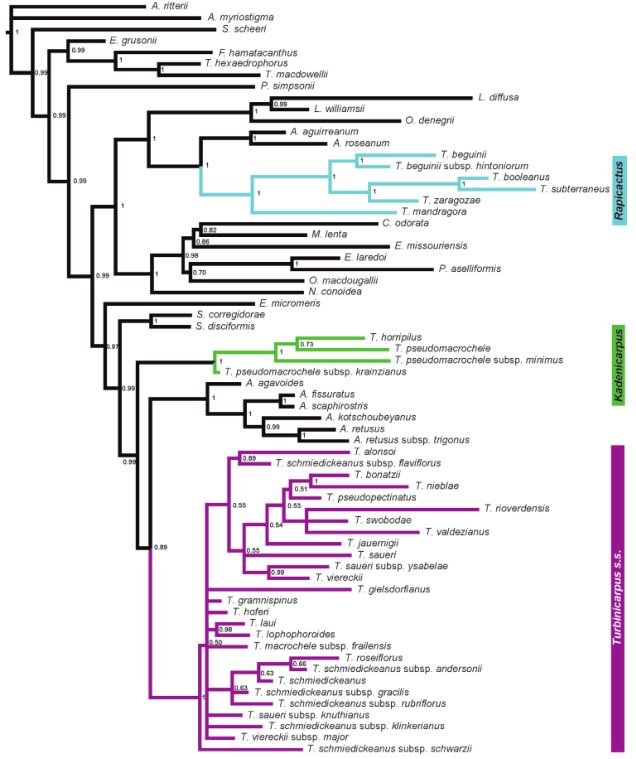DaveW wrote: ↑Fri Jul 24, 2020 2:02 pm
Re Turbinicarpus Aioinopsis asked about. I note Joel's remark in my last link above:-
"In August 2019, a new molecular study (Vázquez-Sánchez et al.) confirmed that Turbinicarpus should be split into three genera: Turbinicarpus sensu stricto, Rapicactus and Kadenicarpus, already suggested in Taxonomy of the Cactaceae second volume as the “clade B1”.
Rapicactus and Kadenicarpus contain the beguinii types that were once called Gymnocactus and Turbinicarpus sensu stricto the familiar low growing klinkerianus types.
A molecular study cannot confirm, prove or suggest that a genus should be split into smaller genera (or be merged with another genus, for that matter). If it indicates that a genus, as currently treated, isn't monophyletic then there are always at least two ways in which it can be made monophyletic and which approach to take is a choice.
Taking Turbinicarpus as an example, the article quoted does indeed indicate that Turbinicarpus isn't monophyletic.

- turb snip.JPG (69.76 KiB) Viewed 2780 times
Splitting it into three (the cyan, green and purple branches) would fix this but so would enlarging the genus to include Ariocarpus, Strombocactus, Epithelantha, Neolloydia, Ortegocactus, Pelecyphora, Cumarina, Acharagma, Obregonia, Lophophora plus a few others (under whatever the oldest name is). None of these is a very large genus (quite a few are monotypic) and the resultant genus would be a reasonable size. Another less unpalatable option might be to do some partial merging around some of the main branches. Then again, maybe you should split it into 4 genera: T. mandragora is basal to the rest of Rapicactus by some way - maybe it should get its own monotypic genus. My point is that there are always several options! Having said that, recognition of Rapicactus, Kadenicarpus and Turbinicarpus does seem the least disruptive option.
It's a similar story with both Parodia and Echinopsis, only this time there are classifications that have gone with the very big and very small genus options. The enlarged Parodia (Taylor's 1987 classification) is monophyletic but so is the recognition of Parodia, Notocactus, Eriocephala, Acanthocephala, Brasiliparodia, Wigginsia, Ritterocactus and Bolivicactus (Doweld's 2000 classification). The traditional 2-genus (Parodia and Notocactus option) isn't monophyletic. For Echinopsis, you can make monophyletic genera as Schlumpberger did in 2012 by recognising Acanthocalycium, Chamaecereus, Echinopsis, Lobivia, Soehrensia, Reicheocactus, Setiechinopsis, Trichocereus and Leucostele (and shuffling some species between the genera) or you can enlarge Echinopsis as Anceschi & Magli proposed (and partially did) in 2013 by including Cleistocactus, Oreocereus, Borzicactus, Vatricania, Weberbauerocereus, Matucana, Denmoza, Harrisia, Samaipaticereus, Yungasocereus, Espostoa, Haageocereus, Mila, Oroya, Pygmaeocereus and Rauhocereus. Both work.










